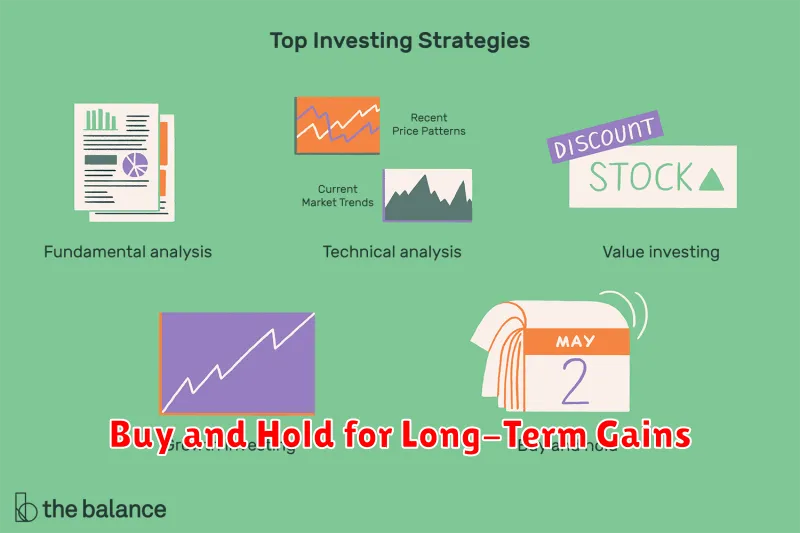Navigating the dynamic world of cryptocurrency requires a keen understanding of profitable investment strategies. This article unveils 10 proven methods to maximize your returns in the evolving landscape of cryptocurrency investment in 2025. Whether you’re a seasoned investor or just beginning your crypto journey, discover effective techniques to capitalize on market trends, mitigate risks, and secure your financial future through smart cryptocurrency trading and portfolio diversification strategies. Learn how to leverage blockchain technology to unlock profitable crypto investment opportunities in the year ahead.
Buy and Hold for Long-Term Gains

The buy-and-hold strategy is a cornerstone of long-term crypto investment success. It involves purchasing cryptocurrencies and holding them for an extended period, typically years, regardless of short-term market fluctuations. This approach leverages the historical tendency of the crypto market to appreciate over time, mitigating the impact of temporary price dips.
Patience is key to this strategy. While short-term trading can yield quick profits, it also carries significant risk. Buy-and-hold allows investors to ride out market volatility, potentially reaping substantial rewards as the value of their holdings increases over the long term. Thorough research into promising projects and a diversified portfolio are crucial for minimizing risk and maximizing potential returns within a buy-and-hold approach. This strategy benefits from dollar-cost averaging, where regular investments are made regardless of price, smoothing out volatility and reducing the risk of buying high.
Tax implications should be considered. Long-term capital gains taxes are often lower than short-term capital gains taxes, offering a potential tax advantage to this approach. However, it’s important to consult with a tax professional to understand the specific tax implications in your jurisdiction.
Ultimately, the buy-and-hold strategy requires discipline and a long-term perspective. It’s best suited for investors with a higher risk tolerance and a willingness to withstand short-term market downturns for the potential of substantial long-term gains.
Diversify Across Multiple Coins

Diversification is crucial in mitigating risk within the volatile cryptocurrency market. Investing in a single coin exposes you to significant losses should that coin underperform. A diversified portfolio, however, spreads your investment across multiple cryptocurrencies with varying market caps, use cases, and technologies.
Consider diversifying across different asset classes within crypto, such as Bitcoin (store of value), Ethereum (smart contracts), and promising altcoins with unique functionalities. This strategy reduces the impact of any single coin’s price fluctuation on your overall portfolio value.
The optimal level of diversification depends on your risk tolerance and investment goals. However, allocating your funds to at least 5-10 different cryptocurrencies is generally recommended to achieve a reasonable balance between risk and reward. Always conduct thorough research before investing in any cryptocurrency.
Staking for Passive Income

Staking is a passive income strategy where you lock up your cryptocurrency holdings to support the network’s operations. In return, you earn rewards in the form of more cryptocurrency.
The rewards vary depending on the cryptocurrency, the amount staked, and the network’s demand. Some platforms offer higher annual percentage yields (APYs) than others. It’s crucial to research thoroughly before selecting a staking platform and cryptocurrency.
Risk is involved, including the potential for smart contract vulnerabilities or fluctuations in the value of the staked cryptocurrency. However, for long-term investors, staking offers a potentially attractive passive income stream.
Before engaging in staking, it is essential to understand the specific terms and conditions of the chosen platform and cryptocurrency. This includes understanding the locking period, unstaking penalties, and associated fees.
Invest in DeFi Projects

Decentralized Finance (DeFi) presents exciting opportunities for crypto investment in 2025. DeFi projects offer diverse avenues for profit, including yield farming, staking, and lending. However, thorough research is crucial. Assess the project’s team, technology, and audits before investing. Diversification across various DeFi protocols is also recommended to mitigate risk.
Yield farming, for instance, involves lending crypto assets to earn interest. However, understanding the associated risks, such as impermanent loss and smart contract vulnerabilities, is paramount. Similarly, staking allows users to lock up their tokens to secure a blockchain network and earn rewards, but the rewards can fluctuate. Lending platforms offer interest on deposited crypto assets but involve counterparty risk.
Before committing funds, carefully evaluate the security and reputation of any DeFi platform. Consider the project’s governance model, tokenomics, and overall market sentiment. Remember that the DeFi space is dynamic, and careful monitoring and a well-defined risk management strategy are essential.
Focus on Low-Market-Cap Coins

Investing in low-market-cap cryptocurrencies presents a high-risk, high-reward opportunity. These coins, with smaller market capitalizations, have the potential for significant price appreciation if they gain traction. However, they are also significantly more volatile and susceptible to manipulation.
Due diligence is paramount. Thoroughly research the project’s team, technology, use case, and whitepaper. Analyze the tokenomics to understand token distribution and inflation. Look for projects with strong community support and a clear roadmap.
Diversification within this segment is crucial. Don’t put all your eggs in one basket. Spread investments across several promising low-market-cap projects to mitigate risk.
Risk management is essential. Only invest what you can afford to lose. Set stop-loss orders to limit potential losses and consider a phased investment approach to manage risk effectively. Be prepared for significant volatility and potential losses.
Remember that the cryptocurrency market is highly speculative. While low-market-cap coins offer the potential for substantial returns, they also carry considerable risk. Thorough research and a conservative investment strategy are critical for success.
Join Liquidity Pools

Joining liquidity pools is a strategy that allows investors to earn passive income by providing liquidity to decentralized exchanges (DEXs). By contributing cryptocurrency pairs to a pool, users earn trading fees proportional to their share of the pool. Yields can be substantial, but the strategy comes with risks, including impermanent loss, where the value of your deposited assets decreases compared to holding them individually.
Impermanent loss is a crucial factor to consider. If the price ratio of your deposited assets changes significantly, you might end up with less value than if you held them outside the pool. Careful research and an understanding of the risks are essential before participating. Diversification across multiple pools and strategies can help mitigate potential losses.
The potential for high returns makes liquidity pools an attractive option, but the risks associated with impermanent loss and smart contract vulnerabilities must be carefully evaluated. Thorough due diligence, including understanding the specific DEX platform and the risks involved with the specific tokens within the pool, is critical for informed decision-making.
Explore Play-to-Earn Platforms

Play-to-earn (P2E) platforms represent a novel investment opportunity within the crypto space. These platforms allow users to earn cryptocurrency by playing games, often involving NFTs (non-fungible tokens) and in-game assets.
Potential profits stem from the appreciation of in-game assets, which can be traded on marketplaces. However, risks exist, including market volatility impacting the value of earned crypto and the potential for game popularity to wane, devaluing assets.
Careful research is vital. Consider the platform’s game mechanics, tokenomics, development team, and community engagement before investing. Diversification across multiple P2E platforms is recommended to mitigate risks.
Successful participation often requires a time investment and strategic gameplay alongside a keen understanding of the underlying blockchain technology and token economics. It’s crucial to view P2E as a long-term strategy, not a get-rich-quick scheme.
Use Dollar-Cost Averaging

Dollar-cost averaging (DCA) is a powerful strategy for mitigating risk in volatile cryptocurrency markets. Instead of investing a lump sum at a potentially high price point, DCA involves investing a fixed amount of money at regular intervals (e.g., weekly or monthly).
This approach helps to reduce the impact of market fluctuations. If the price drops, you buy more crypto for your fixed investment. Conversely, if the price rises, you buy less. Over time, this strategy averages out your purchase price, lessening the risk of buying high and potentially leading to better overall returns compared to a single large investment.
Consistency is key to successful DCA. Sticking to your predetermined schedule, regardless of market sentiment, is crucial to realizing the benefits of this strategy. DCA is not a guaranteed path to riches, but it’s a valuable tool for managing risk and building a cryptocurrency portfolio steadily and prudently.
Follow Smart Money Trends

Tracking smart money movements is crucial for profitable crypto investment. These large institutional investors and whales often possess superior market intelligence and resources. By observing their activities – such as significant buys or sells in specific cryptocurrencies – you can gain valuable insights into potential market shifts. Analyzing on-chain data, like exchange inflows and outflows, can help identify these trends.
However, blindly following smart money isn’t a guaranteed path to success. Independent research and risk assessment remain vital. Diversification across multiple assets is also key to mitigating potential losses. Smart money activity should be considered one factor among many in your overall investment strategy, not the sole determinant.
Tools like on-chain analytics platforms provide data visualization, simplifying the process of identifying trends. Remember, smart money often operates with a long-term perspective. Consider your own investment timeframe and risk tolerance before making decisions based on observed trends.
Invest in Blockchain Startups

Investing in blockchain startups offers high-growth potential but also carries significant risk. Early-stage companies developing innovative blockchain technologies or applications could yield substantial returns if successful. Thorough due diligence is crucial, focusing on the team’s expertise, the technology’s viability, and the market’s demand for the proposed solution. Consider factors like the company’s funding rounds, tokenomics (if applicable), and the overall market conditions before investing.
Diversification within your blockchain startup portfolio is essential to mitigate risk. Don’t put all your eggs in one basket. Spread your investments across various sectors within the blockchain ecosystem, such as decentralized finance (DeFi), non-fungible tokens (NFTs), and supply chain management solutions. This approach can help cushion potential losses from individual company failures.
Remember that investing in startups involves a long-term perspective. Significant returns may not be immediate. Be prepared for potential periods of stagnation or even losses before seeing positive results. Patience and careful monitoring of your investments are key to success in this high-risk, high-reward sector.
